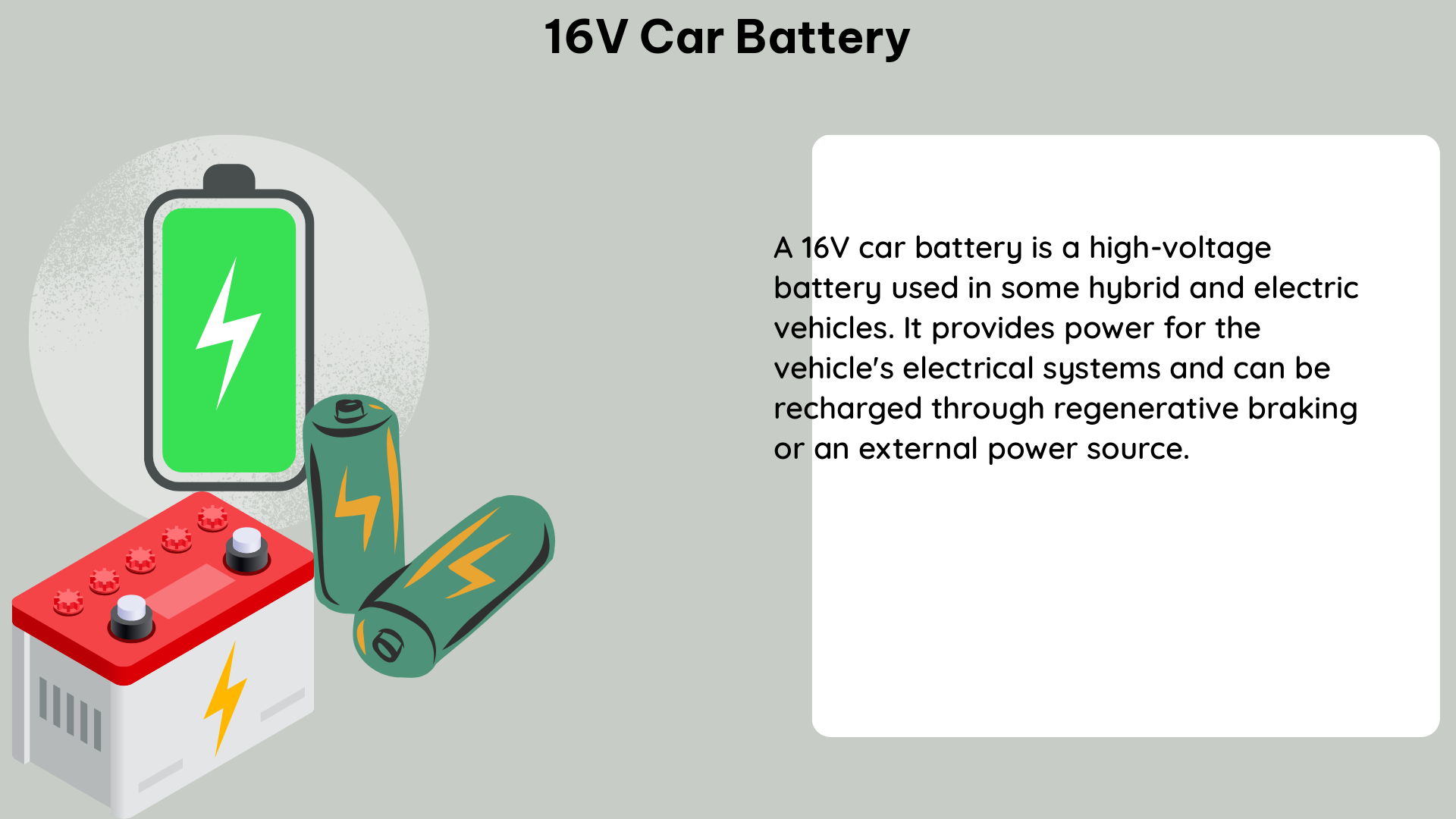The 16v car battery is a specialized power source designed for high-performance vehicles, particularly in the realm of drag racing. This battery offers a significantly higher voltage range compared to the standard 12v system, providing numerous benefits for the ignition system, fuel injectors, and overall vehicle performance.
Understanding the 16v Car Battery
The 16v car battery operates at a nominal voltage of 16 volts, which is a significant increase from the traditional 12-volt system. This higher voltage range is achieved through the use of specialized lead-acid or lithium-ion battery chemistry, carefully engineered to deliver the necessary power and reliability required for demanding racing applications.
Technical Specifications
- Voltage: 16 volts
- Capacity: Ranging from 40 Ah (Ampere-hours) to 200 Ah, depending on the specific application and battery type
- Battery Chemistry: Lead-acid or lithium-ion
- Terminal Type: Standard automotive terminals (positive and negative)
- Size and Weight: Varies based on the capacity and battery type, with larger-capacity batteries typically being heavier and physically larger
- Charging Voltage: 16 volts for lead-acid batteries, or a specific charging voltage for lithium-ion batteries, as recommended by the manufacturer
Benefits of the 16v Car Battery
The higher voltage range provided by the 16v car battery offers several key advantages for high-performance vehicles:
- Improved Ignition System Performance: The increased voltage ensures a stronger and more consistent spark, leading to more efficient combustion and improved engine response.
- Enhanced Fuel Injection Efficiency: The higher voltage allows for more precise control and faster response times of the fuel injection system, resulting in better fuel atomization and increased power output.
- Reduced Voltage Drop: The 16v system experiences less voltage drop during high-current draw situations, such as during acceleration or under heavy load, maintaining a more consistent voltage supply to critical components.
- Increased Alternator Efficiency: The 16v system allows for the use of a higher-output alternator, which can more effectively recharge the battery and power the vehicle’s electrical systems during extended racing events.
- Improved Battery Life: The 16v battery’s higher voltage range can help extend the battery’s lifespan, as it operates within a more optimal voltage range compared to a standard 12v system.
Installing a 16v Car Battery

Upgrading to a 16v car battery requires careful consideration and proper installation procedures to ensure the safety and reliability of the system. Here’s a step-by-step guide to the installation process:
- Disconnect the Negative Terminal: Begin by disconnecting the negative (-) terminal of the existing 12v battery to prevent any potential short circuits during the installation process.
- Remove the 12v Battery: Carefully remove the existing 12v battery from the vehicle, taking note of the battery hold-down mechanism and any wiring connections.
- Install the 16v Battery: Place the 16v battery in the same location as the previous 12v battery, using the same hold-down mechanism to secure it in place.
- Connect the Positive Terminal: Connect the positive (+) terminal of the 16v battery first, ensuring a secure and tight connection.
- Connect the Negative Terminal: Next, connect the negative (-) terminal of the 16v battery, again ensuring a secure and tight connection.
- Check Wiring Connections: Thoroughly inspect all wiring connections to confirm they are properly secured and free from any damage or corrosion.
- Perform a Voltage Check: Use a multimeter to verify that the 16v battery is providing the correct voltage output, typically around 16 volts.
It’s important to note that the installation process may vary depending on the specific vehicle and battery type. Always refer to the manufacturer’s instructions or consult a professional mechanic if you’re unsure about any part of the installation.
Maintaining the 16v Car Battery
Proper maintenance is crucial for ensuring the longevity and optimal performance of your 16v car battery. Here are some key maintenance tips:
- Regular Cleaning: Regularly clean the battery terminals and connections to prevent corrosion, which can impede the flow of electrical current.
- Voltage Monitoring: Periodically check the battery’s voltage using a multimeter to ensure it’s within the recommended range, typically around 16 volts.
- Charging Considerations: For lead-acid 16v batteries, use a dedicated 16v charger to ensure the battery is charged correctly. For lithium-ion batteries, follow the manufacturer’s recommended charging procedures.
- Temperature Awareness: Extreme temperatures, both hot and cold, can negatively impact the battery’s performance and lifespan. Park the vehicle in a climate-controlled environment whenever possible.
- Replacement Timing: Monitor the battery’s condition and replace it when necessary, as recommended by the manufacturer or based on its performance and age.
Conclusion
The 16v car battery is a specialized power source that offers significant advantages for high-performance vehicles, particularly in the realm of drag racing. By providing a higher voltage range, the 16v battery can improve ignition system performance, enhance fuel injection efficiency, and increase overall system reliability. With proper installation and maintenance, the 16v car battery can be a valuable upgrade for enthusiasts seeking to extract the maximum performance from their vehicles.
References:
- Converting to a 16 Volt System – LS1TECH
- 12V to 16V Conversion – Racingjunk Forums
- Why do my batteries show 16v? | YBW Forum
- Why An Alternator And 16-Volt System Are Beneficial For Drag Racers

The lambdageeks.com Core SME Team is a group of experienced subject matter experts from diverse scientific and technical fields including Physics, Chemistry, Technology,Electronics & Electrical Engineering, Automotive, Mechanical Engineering. Our team collaborates to create high-quality, well-researched articles on a wide range of science and technology topics for the lambdageeks.com website.
All Our Senior SME are having more than 7 Years of experience in the respective fields . They are either Working Industry Professionals or assocaited With different Universities. Refer Our Authors Page to get to know About our Core SMEs.